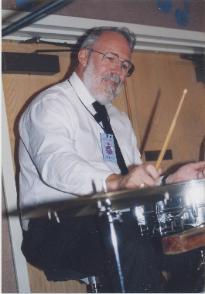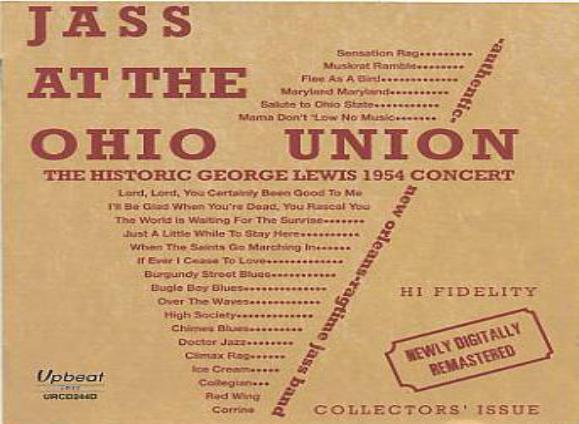CD REVIEW
by Bert Thompson
GEORGE LEWIS— JASS AT THE OHIO UNION • THE HISTORIC GEORGE
LEWIS 1954 CONCERT (Upbeat URCD244D).
CD 1
Introduction/Basin Street Blues; Beautiful Ohio; Collegiate; Mama Don’t ’low [sic]†;
Climax Rag; Lord, Lordº; High Society; If Ever I Cease to Love; The World Is Waiting
for the Sunrise‡; Maryland, My Maryland; Funeral Sequence**: Just a Little While to
Stay Here/Flee as a Bird/You Rascal, You; Burgundy Street Blues. Playing time: 51
mins. 31 secs.
CD 2
Over the Waves; Bugle Boy March; Doctor Jazz†; Red Wing; Sensation Rag; Corrine,
Corrina†; Ice Cream†º; When the Saints Go Marching Inº; Chimes Blues; Muskrat
Ramble; Finale/Basin Street Blues*. (Note: Chimes Blues actually precedes the Saints
on the CD itself.)
Playing time: 50 mins. 59 secs.
Recorded at Ohio State University, Columbus, Ohio, on Mar. 3, 1954.
Personnel: George Lewis, clarinet, leader, speaker*; Avery ‘Kid’ Howard, trumpet,
vocalº; Jim Robinson, trombone; Lawrence Marrero, banjo, bass drum**; Alton
Purnell, piano, vocal‡; Alcide ‘Slow Drag’ Pavageau, string bass; Joe Watkins, drums,
vocal†.
By now the George Lewis story is fairly well known, especially among those who are
fans of traditional jazz, particularly that of the New Orleans style. He was unknown
outside of New Orleans until the early 1940’s when he recorded with Bunk Johnson
and later appeared with him at an engagement at the Stuyvesant Casino, New York, in
1945, by which time the traditional jazz revival was underway. While in New York the
Johnson/Lewis band recorded for the major labels Victor and Decca, further
disseminating their jazz and establishing their names.
Returning to New Orleans, the Lewis band, minus Johnson but with other trumpet
players substituting, stayed together and was featured in the June 6, 1950 issue of
Look magazine, which further burnished the band’s reputation. Touring followed,
and the concert contained on these two discs was recorded during one of these tours,
less than a decade after the triumphant New York “debut.” By this time Lewis was
one of the leading exponents, if not the leading one, of the New Orleans branch of the
revival.
This recording makes clear why Lewis occupied such a position. The band is a seven-
piece juggernaut, barreling through all of the up-tempo pieces and steeping the slower-
paced blues pieces in sentiment, not sentimentalism or bathos. The former are
exemplified in Mama Don’t ’low where the audience roars its approval, or Ice Cream
where again the audience responds loudly, undoubtedly to Jim Robinson’s dancing
around the stage waving his white handkerchief in their direction, making Joe
Watkins’ four-bar tag at the end almost obligatory. Even on a blues like Corrine,
Corrina, we hear Joe Watkins exhorting Jim Robinson to “Slide, Jim, Slide!” and
George Lewis to “Blow, George, Blow!” as they solo. And the audience responds in
kind to all of this exuberance on the stand.
The audience, somewhat remarkable by today’s standards, is a young, white one,
being composed of college students from Ohio State. (As such, they rather dutifully
clap time on the beat; even when led initially by one of the musicians to clap on the
off-beat, as soon as he stops clapping to play, they drift back to on the beat!) But they
certainly do respond to the music, even though there is nary a guitar in sight.
At the time of this concert, most of the tunes in the play lists of these two CD’s were
fresh. Even When the Saints Go Marching In had not yet become the war horse it was
later to become. And many of the tunes were to become standards in the revivalist
band’s repertoires. Indeed many of the bands in the U.K. (in particular Ken Colyer’s),
Europe, and even Japan were to take the Lewis band as a template or at least point of
departure. And listening to these recordings, one can easily see why that would be so.
For sheer excitement the Lewis band is high on the scale—one would be hard pressed
to find a hotter band. At the time of this recording, unfortunately Kid Howard was
having lip problems and hence cannot play with his usual verve. Even so, his playing
is more than adequate, and the others are all in top form.
Since this is a live recording, not done under optimum conditions, there are a few
minor problems, such as sound balance being a little off, starts missing a note or two,
and the rather disconcerting (to me) abrupt ending of some tracks, probably to
eliminate audience reaction. (But those tracks where we are permitted to hear the
response convincingly demonstrate just how well the band was being received.)
While many fans of this type of jazz may already have the Storyville double CD issue
or the Disc Jockey double LP issue of this concert, this current CD issue, part of
Upbeat’s Lewis reissue program, has the benefit of the digital transfers. Those new to
Lewis could hardly have a better introduction. And all of us who are contemporaries
of those who were in the audience that night can sit back and indulge in some
nostalgia for some hour and three quarters. Lewis himself said that his was “the last of
the real New Orleans jazz bands,” and that was no idle claim.
This double CD can probably be purchased in the U.S. at Jazzbymail, which stocks
Ubeat releases, at www.jazzbymail.com, or at the Upbeat website, www.upbeat.co.uk,
which provides for ordering by mail if one clicks on New Releases.
|
|



